The High-Resolution Anoscopy Market is estimated to be valued at USD 16.6 billion in 2025 and is projected to reach USD 29.7 billion by 2035, registering a compound annual growth rate (CAGR) of 6.0% over the forecast period.
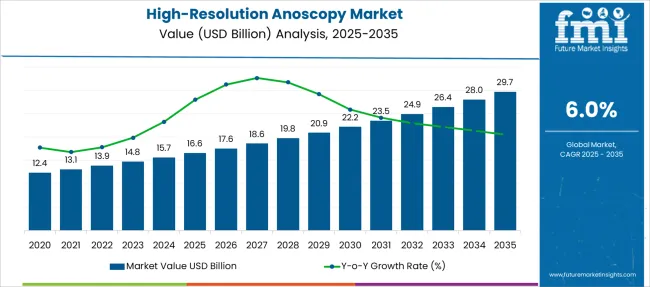
| Metric | Value |
|---|---|
| High-Resolution Anoscopy Market Estimated Value in (2025 E) | USD 16.6 billion |
| High-Resolution Anoscopy Market Forecast Value in (2035 F) | USD 29.7 billion |
| Forecast CAGR (2025 to 2035) | 6.0% |
The high-resolution anoscopy market is experiencing steady expansion, supported by the growing emphasis on targeted screening and diagnosis of anal intraepithelial neoplasia and HPV-related malignancies. Clinical guidelines are increasingly recommending high-resolution anoscopy for high-risk populations, which is accelerating the demand for precision imaging solutions in colorectal and gynecological diagnostics.
Technological advancements in optics, digital magnification, and LED illumination have significantly improved visualization and biopsy accuracy, thereby improving procedural outcomes. Regulatory support for early cancer detection and the increasing use of preventive screening across oncology departments are driving market engagement from both public and private healthcare providers.
The incorporation of portable and software-integrated devices is further expanding access in outpatient settings and ambulatory surgical centers With growing awareness among clinicians and patients, coupled with rising procedural volumes in urban and semi-urban healthcare infrastructures, the market is expected to witness consistent growth over the next few years, particularly as training programs and specialist availability continue to scale globally.
The market is segmented by Product Type, Hand-Held Colposcope, and End Use and region. By Product Type, the market is divided into Colposcopes and Portable Colposcope. In terms of Hand-Held Colposcope, the market is classified into Anoscopes, Disposable Anoscope, and Reusable Anoscope. Based on End Use, the market is segmented into Hospitals, Diagnostic Laboratories, and Specialty Clinics. Regionally, the market is classified into North America, Latin America, Western Europe, Eastern Europe, Balkan & Baltic Countries, Russia & Belarus, Central Asia, East Asia, South Asia & Pacific, and the Middle East & Africa.

The colposcopes segment is projected to account for 28.4% of the revenue share in the high-resolution anoscopy market in 2025. The strong presence of this segment is being driven by its proven optical clarity, stable magnification systems, and long-standing use in identifying precancerous lesions. Colposcopes provide high-quality visualization of mucosal surfaces, which has facilitated their clinical adoption in both gynecological and anal examinations.
The integration of digital imaging modules and real-time display systems has enhanced diagnostic confidence and procedural documentation. Hospitals and specialty clinics have preferred colposcopes due to their ergonomic design and ability to support adjunct diagnostic tools, making them suitable for high-volume screening programs.
Additionally, enhanced compatibility with biopsy instruments and auxiliary lighting systems has improved procedural precision, further strengthening their clinical relevance The continued development of compact, software-assisted colposcope models is also enabling broader deployment across varied healthcare environments, particularly where detailed lesion mapping and guided interventions are required.
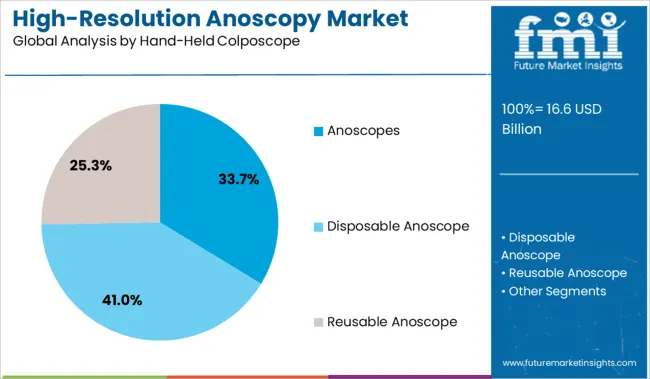
The anoscopes segment is expected to lead the product landscape with 33.7% of the total revenue share in 2025, reflecting its pivotal role in facilitating direct and cost-effective visualization of the anal canal. The dominance of this segment has been supported by its straightforward design, reusability, and clinical reliability in conducting routine screenings and high-resolution evaluations.
Anoscopes are widely utilized in both hospital and outpatient settings due to their minimal training requirements and ease of integration with optical systems. The segment has gained traction as healthcare providers increasingly focus on standardizing anal cancer screening protocols, particularly in immunocompromised and high-risk patient populations.
Recent product improvements in materials, lighting options, and ergonomics have further enhanced procedural efficiency and patient comfort The segment's growth has also been influenced by rising awareness among healthcare professionals regarding the importance of early detection and the availability of anoscopes tailored for compatibility with digital imaging systems in high-resolution anoscopy workflows.
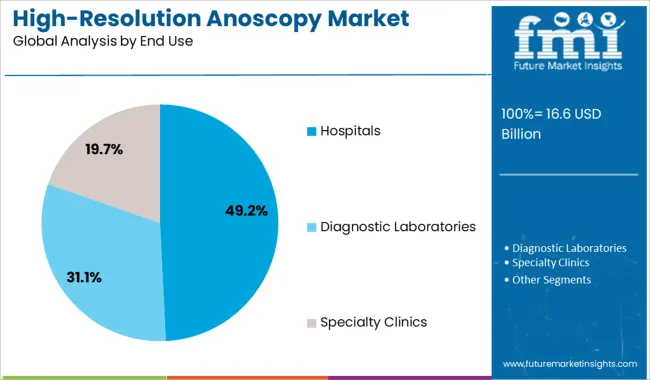
The hospital end use segment is projected to account for 49.2% of the revenue share in the high-resolution anoscopy market by 2025, establishing itself as the primary setting for procedural adoption. The segment's leadership is being supported by the availability of advanced diagnostic infrastructure, trained personnel, and higher procedural throughput.
Hospitals are increasingly serving as referral centers for high-risk screenings, especially among immunocompromised patients and those with HPV-related conditions, which has contributed to the rising utilization of high-resolution anoscopy systems in this setting. Centralized procurement capabilities and compliance with evolving clinical guidelines have further encouraged investment in high-definition diagnostic platforms.
The integration of electronic medical record systems and image archiving solutions within hospitals has also improved procedural documentation and follow-up care As initiatives around early cancer detection and preventive screening become more institutionalized, the role of hospitals in delivering high-quality anoscopy procedures is expected to expand further, making this segment a consistent driver of market revenue.
The increasing prevalence of anal cancer is one of the main factors fuelling the demand for high-resolution anoscopy to a considerable extent.
The rising adoption of high-resolution anoscopy can also be attributed to the increasing population globally.
An increase in research and developmental activities can as well propel the adoption of high-resolution anoscopy.
The promotion of research programs is also a factor that can help in the detection and treatment of anal dysplasia and anal cancer, augmenting the demand for high-resolution anoscopy.
Other factors influencing the adoption of high-resolution anoscopy include increasing healthcare awareness, increasing the geriatric population, etc.
The demand for high-resolution anoscopy is also positively impacted by the increasing number of diagnostic laboratories resulting increased diagnosis rate.
The safety and efficacy of anoscopes are projected to augment the demand for high-resolution anoscopies.
However, the high cost of treatment is likely to hinder the adoption of high-resolution anoscopy.
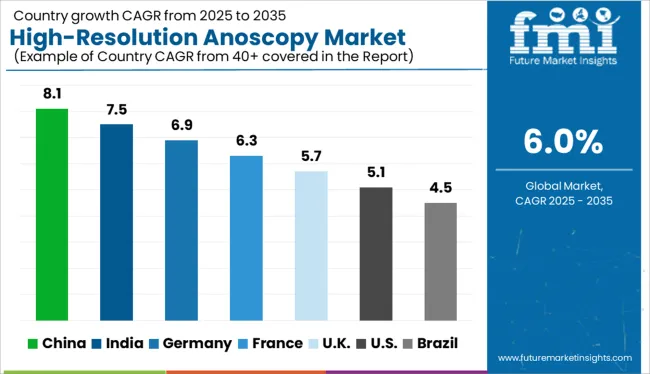
On the basis of geography, the global high-resolution anoscopy market has been fragmented into several key regions i.e. North America, Latin America, Europe, East Asia, South Asia, Oceania, and Middle East and Africa.
North America is expected to hold the largest high-resolution anoscopy market share primarily due to the presence of a large number of hospitals and advanced healthcare infrastructure.
Europe is also expected to capture a sizeable high-resolution anoscopy market share on account of the presence of a large number of biological industries and also due to the presence of a large population.
The adoption of high-resolution anoscopy in Asia is expected to move forward at a rapid pace due to increasing healthcare awareness and an increasing number of hospitals and diagnostic laboratories.
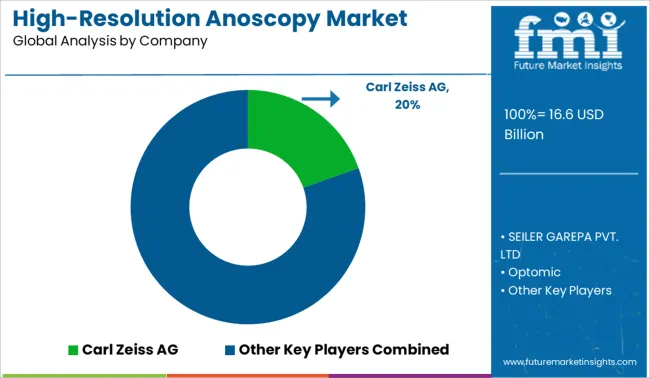
Some of the key players present in the global high-resolution anoscopy market are Carl Zeiss AG and SEILER GAREPA PVT. LTD, Optomic, Lutech, Medimarcorp., Ecleris, Genius Plus AB, Bovie Medical Corporation, and GoldCare.
The key market players are executing various strategies such as mergers & acquisitions, collaborations, and partnerships, amongst others in order to augment their high-resolution anoscopy market share.
| Report Attribute | Details |
|---|---|
| Base Year for Estimation | 2024 |
| Historical Data | 2020 to 2024 |
| Forecast Period | 2025 to 2035 |
| Quantitative Units | Revenue in USD Million, Volume in Kilotons, and CAGR from 2025 to 2035 |
| Report Coverage | Revenue Forecast, Volume Forecast, Company Ranking, Competitive Landscape, Growth Factors, Trends, and Pricing Analysis |
| Segments Covered | Product Type, End Use, Region |
| Regions Covered | North America; Latin America; Western Europe; Eastern Europe; Asia Pacific excluding Japan; Japan; Middle East and Africa |
| Key Countries Profiled | USA, Canada, Brazil, Argentina, Germany, United Kingdom, France, Spain, Italy, Nordics, BENELUX, Australia & New Zealand, China, India, ASIAN, GCC Countries, South Africa |
| Key Companies Profiled | Carl Zeiss AG; SEILER GAREPA PVT. LTD; Optomic; Lutech; Medimarcorp.; Ecleris; Gynius Plus AB; Bovie Medical Corporation; GoldCare |
| Customization | Available Upon Request |
The global high-resolution anoscopy market is estimated to be valued at USD 16.6 billion in 2025.
The market size for the high-resolution anoscopy market is projected to reach USD 29.7 billion by 2035.
The high-resolution anoscopy market is expected to grow at a 6.0% CAGR between 2025 and 2035.
The key product types in high-resolution anoscopy market are colposcopes and portable colposcope.
In terms of hand-held colposcope, anoscopes segment to command 33.7% share in the high-resolution anoscopy market in 2025.






Full Research Suite comprises of:
Market outlook & trends analysis
Interviews & case studies
Strategic recommendations
Vendor profiles & capabilities analysis
5-year forecasts
8 regions and 60+ country-level data splits
Market segment data splits
12 months of continuous data updates
DELIVERED AS:
PDF EXCEL ONLINE

Thank you!
You will receive an email from our Business Development Manager. Please be sure to check your SPAM/JUNK folder too.
Chat With
MaRIA